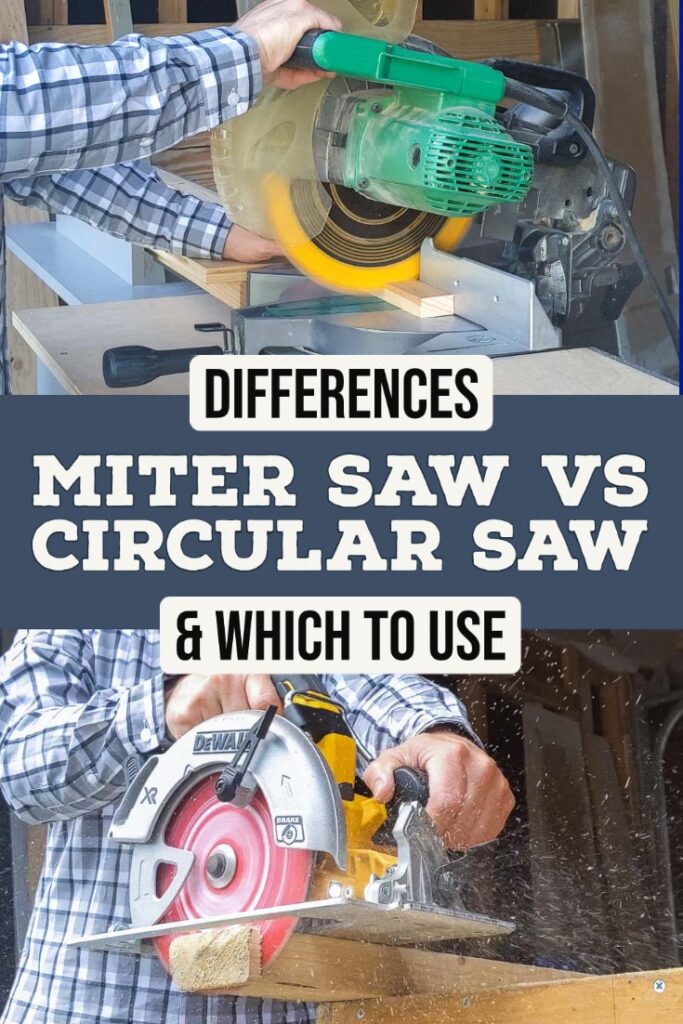Miter Saw vs Circular Saw (Differences + Which to Choose)
Unsure whether to get a miter or circular saw? Learn the differences, when to use each, and which is best for your needs in this comprehensive guide.

Two of the most common power saws on the market are the miter saw and the circular saw. But what’s the difference between them, and which is the right tool for your DIY projects? In this article, we’ll explore the pros and cons of each, so you can decide which saw is best for you. Let’s get started!
This tutorial contains affiliate links to supplies and tools. Purchases made using these links help support the Saws on Skates website and allows me to share more projects and tips with you. There is no cost to you for using these links. Visit my site policies for more information.
Table of Contents
- What is a Miter Saw?
- What is a Miter Saw Used For?
- Types of Miter Saws
- What are the Pros and Cons of a Miter Saw?
- What is a Circular Saw?
- What is a Circular Saw Used For?
- Types of Circular Saws
- What are the Pros and Cons of a Circular Saw?
- What are the Differences Between a Miter Saw and a Circular Saw?
- Should I Buy a Miter Saw or a Circular Saw?
- Frequently Asked Questions
What is a Miter Saw?
A miter saw, also known as a compound miter saw, is used to cut precise crosscuts and complicated angles. It has a pivoting arm with a circular blade that can be turned left or right and tilted from top to bottom. The workpiece is supported against a fence while it’s being cut.
To make a cut, you set the miter saw to the required angle, position the workpiece against the fence, and lower the spinning blade into the material.
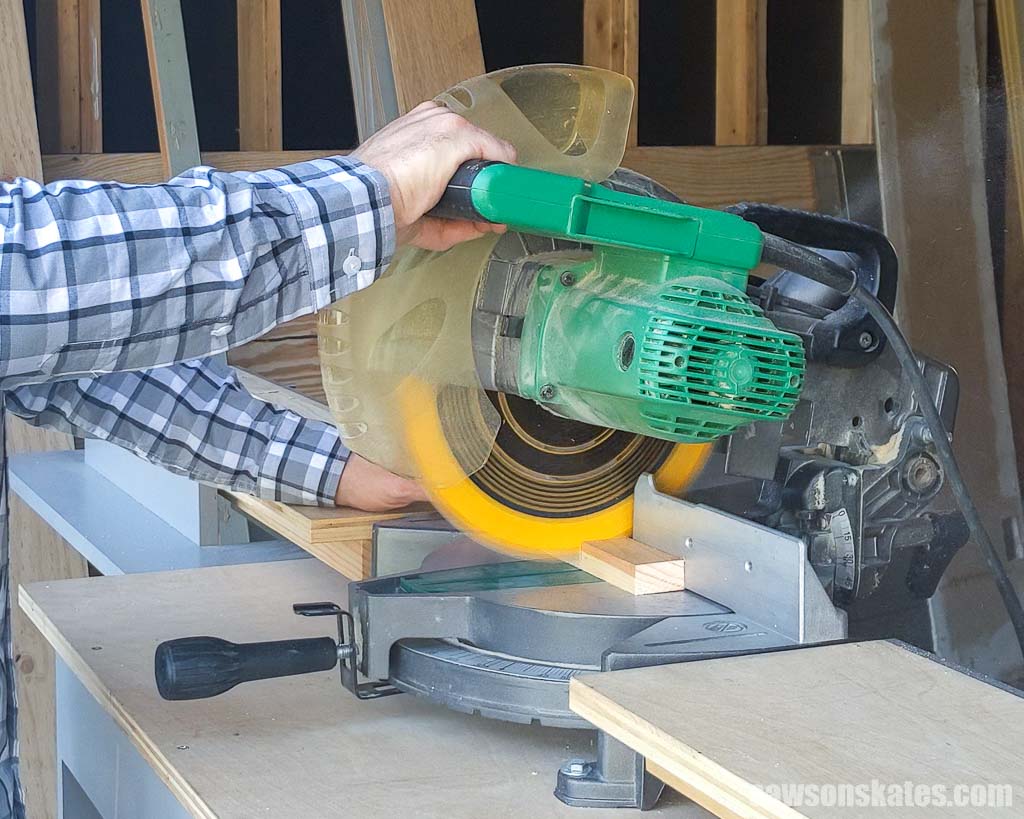
Miter saws range in size and weight and are designed to be used on a worktable or workbench. Smaller, lightweight models are portable, while larger, heavier ones are more challenging to transport and are better suited for use on a dedicated miter saw station.
What is a Miter Saw Used For?
Miter saws are essential for installing trim work like baseboards and crown molding, as well as carpentry and woodworking tasks, such as making accurate miter cuts, bevel cuts, and compound miter cuts.
Crosscut
Crosscuts are made at 90 degrees across the wood grain and are often used to cut boards to length.
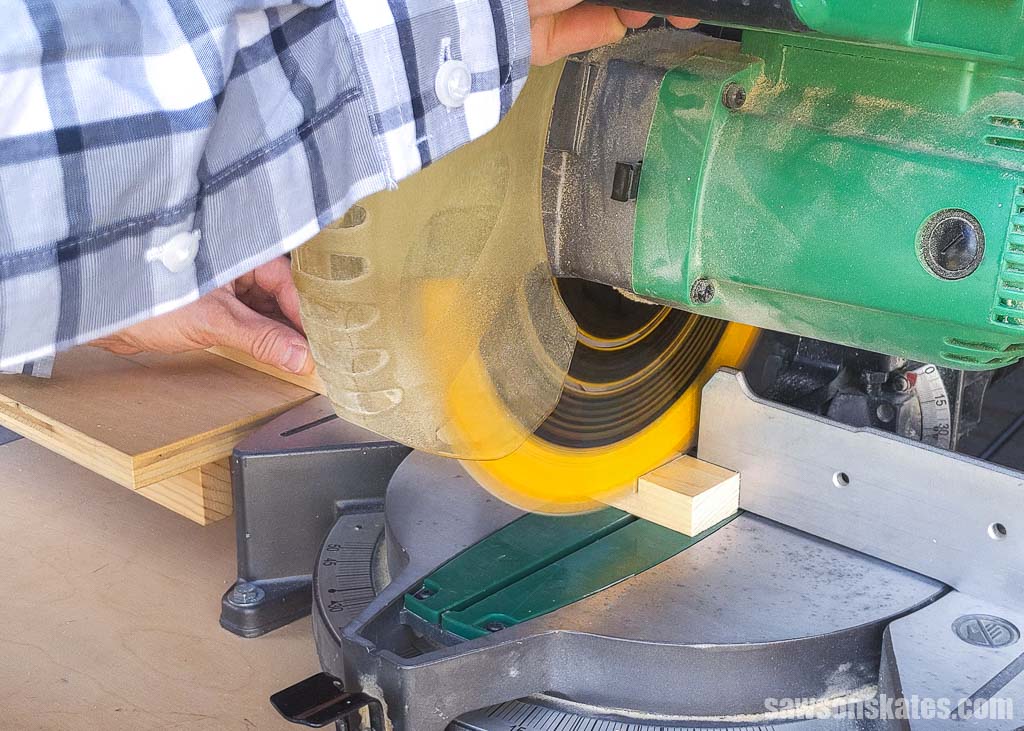
Miter Cut
Miter cuts are made by setting the blade from left to right at an angle other than 90 degrees. For example, you might set the angle to 45 degrees to cut parts for picture frames.
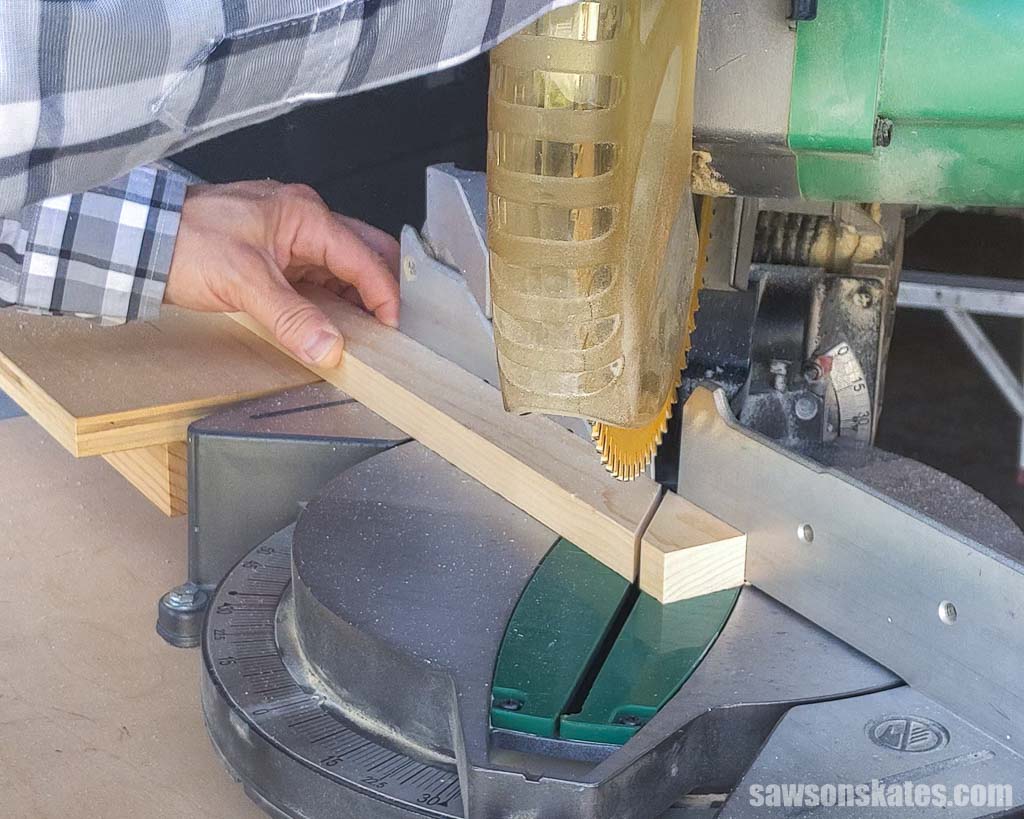
Bevel Cut
Bevel cuts are made by tilting the blade from top to bottom to change the profile of a board.
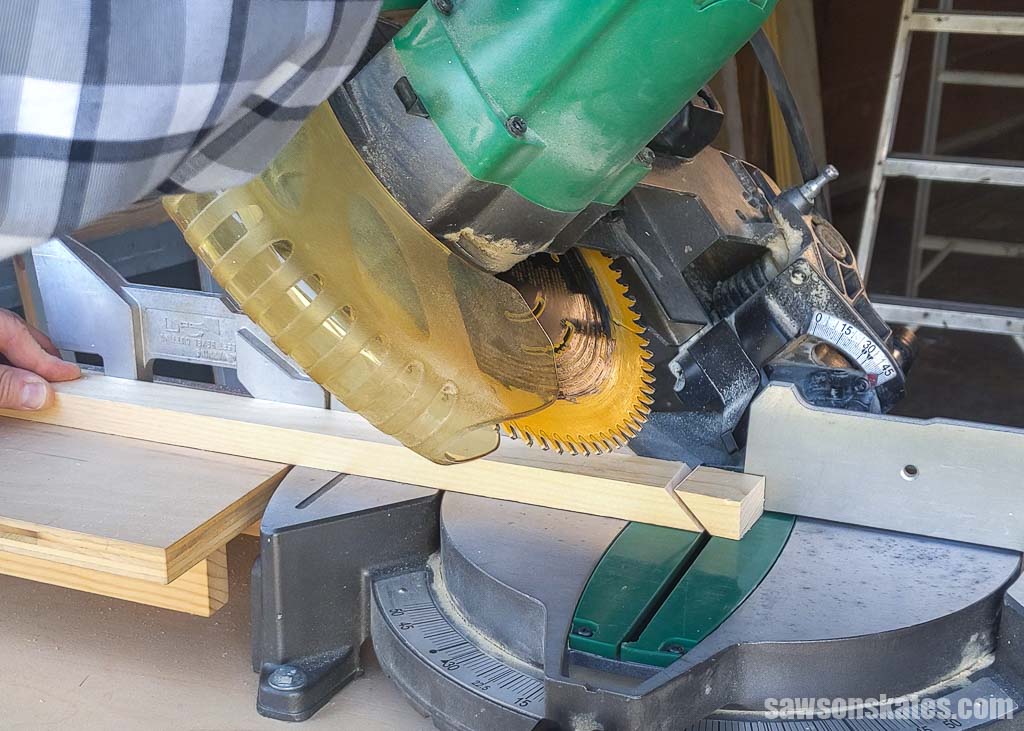
Compound Miter Cut
A compound miter is made up of a miter cut and a bevel cut, setting the blade at an angle from side to side and tilting it from top to bottom. Compound miters are needed to cut crown molding, which is used to finish the tops of walls and cabinets.
One drawback to a miter saw is that it lacks the ability to make rip cuts, which are made parallel to the grain of the wood. For ripping, you’ll need a different tool, such as a circular saw or table saw.
Related: Table Saw vs Miter Saw (Differences + Which to Use)
What are the Different Types of Miter Saws?
Miter saws are available in different types and blade sizes, and understanding the features of each will help you choose the right one for your project.
Single Bevel Compound Miter Saw
A single bevel miter saw, sometimes called a standard miter saw, is the most basic type available. Its blade may be rotated from left to right and tilted from top to bottom in one direction, usually to the left.
If you are a beginner or only need to make basic crosscuts, bevels, and miters, such as corners for trim work, then a single bevel saw is an excellent, budget-friendly option. They are ideal for those DIYers who don’t frequently need to cut crown molding or other complex angles.
Related: Single vs Double Bevel Miter Saw (Which to Buy & Why)
Double Bevel Compound Miter Saw
A double bevel miter saw’s blade may be rotated from left to right and tilted from top to bottom in two directions, left and right.
For those who frequently install crown molding and make cuts for other woodworking tasks, a double bevel saw is the go-to choice for professionals, advanced DIYers, and those with bigger budgets.
Sliding Compound Miter Saw
A sliding miter saw performs the same operations as a compound saw, but the blade is mounted to a rail allowing it to slide back and forth, giving it a greater cutting capacity than a standard miter saw.
Blade Size
The diameter of a miter saw’s blade and whether it’s a compound miter saw or a sliding compound miter saw determine its cutting capacity, which is the maximum width or height of a board the saw can cut.
Most miter saw blades are 10 or 12 inches, while 7-¼ and 8-½ inch blades are used on smaller saws.
Cutting Width
10-inch compound miter saws can crosscut boards up to 5-½ inches wide in one pass, while 12-inch blade can crosscut boards up to 7-½ inches wide in one pass.
Depending on the manufacturer, a sliding compound miter saw may increase the width of these cuts to 12-15 inches.
Related: How to Use a Tape Measure Correctly (Tips for Success)
Depth of Cut
A 10-inch miter saw can cut through wood up to about 3-½ inches thick, while a 12-inch miter saw can cut through even thicker material.
Related: Beginner’s Guide to Wood Sizes
What are the Pros and Cons of a Miter Saw?
Pros
- Makes precise crosscuts, miters, bevels, and compound cuts
- Ideal for cutting boards to length, picture frame parts, and crown molding
Cons
- Lacks the ability to make rip cuts
- Relatively small and lightweight, but heavier and has a larger footprint compared to a circular saw
What is a Circular Saw?
A circular saw, also called Skilsaw, is a handheld power tool with a saw blade mounted above a base plate. The blade protrudes through a slot beneath the plate, which may be raised and lowered to adjust the depth of the cut. The blade also tilts to adjust the angle of the cut.
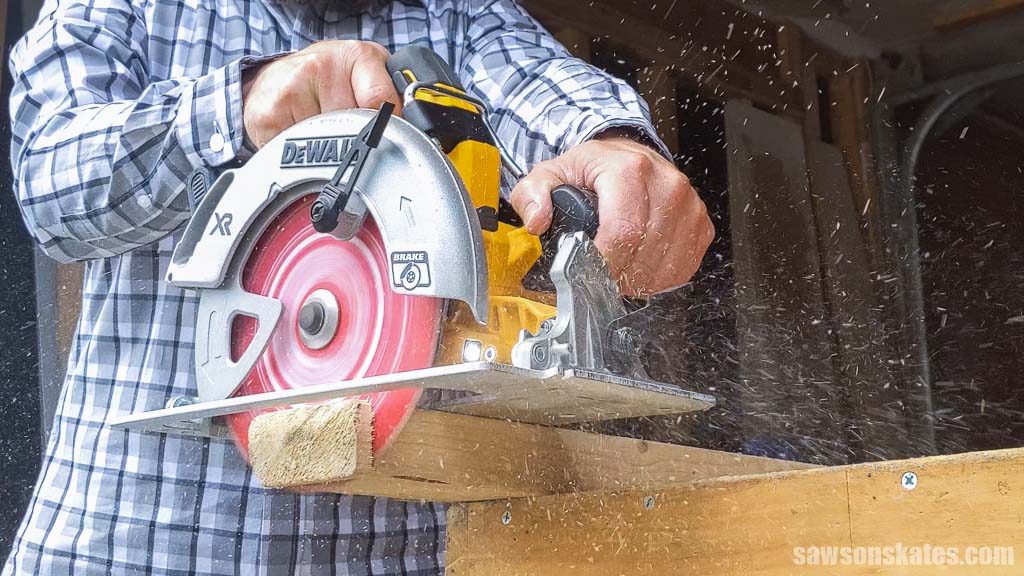
To make a cut with a circular saw, you stand behind the tool with the plate positioned on top of the workpiece. Then you push the saw across the workpiece, guiding the blade along the line you want to cut.
Because a circular saw’s blade is exposed, it’s generally more dangerous to use than a miter saw. However, both are dangerous if not used properly. Always protect your eyes, ears, and lungs, keep your fingers away from the blade, and follow all safety guidelines included with your tool.
What is a Circular Saw Used For?
Circular saws are versatile tools that may be used for cutting materials such as lumber, plywood, and MDF. They can also be used to cut concrete and metal.
Types of Cuts
A circular saw can be used for the same operations as a miter saw, such as making crosscuts, miters, bevels, and compound cuts, but with less accuracy.
One advantage of a circular saw over a miter saw is its ability to make rip cuts. Rip cuts are long, straight cuts made along the length of a workpiece. They are often used to reduce a board’s width or break down plywood sheets to their required size for building cabinets or furniture.
Rip cuts are generally made with the circular saw set at 90 degrees, but they can also be made with the blade tilted to create bevel cuts.
Related: How to Make DIY Cabinet Doors (Without Special Tools)
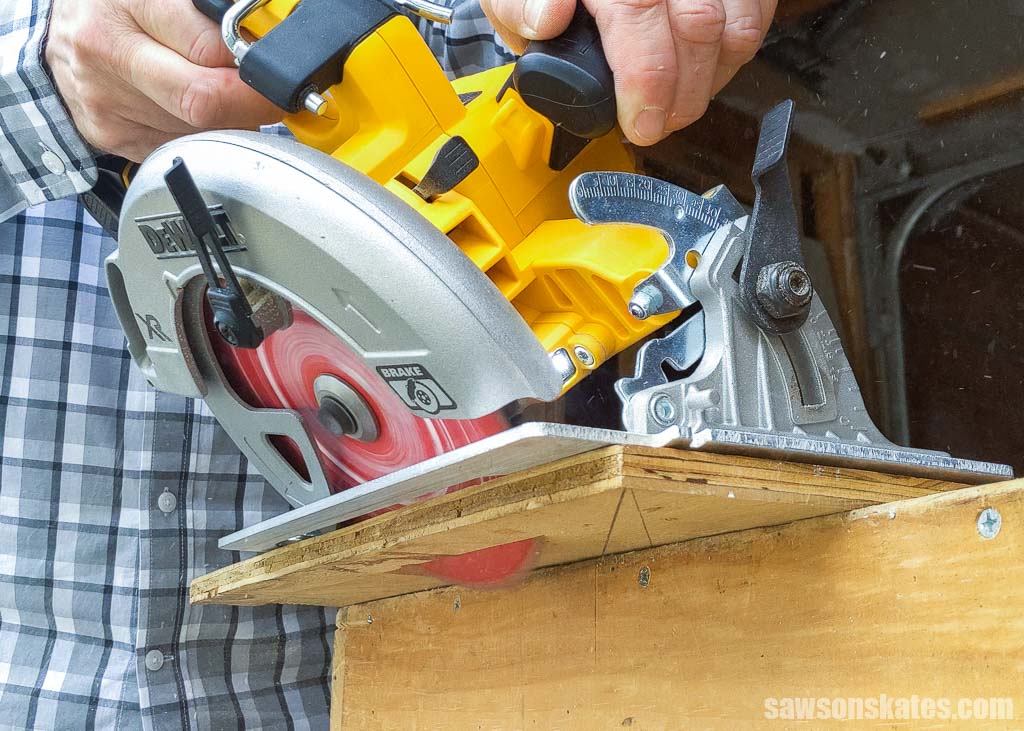
A circular saw may also be used for making long and steep angled cuts, such as roof rafters that are nearly impossible to cut with a miter saw.
Kickback
One drawback of a circular saw is some cutting operations may cause kickback. Kickback is a dangerous situation in which the blade binds in the workpiece, forcing the workpiece or tool back toward you at a high rate of speed.
Circular saws bind most often when the workpiece is not adequately supported. When cutting a large plywood sheet, for example, be sure to support the sheet on both sides and along the cut line.
I’ve mistakenly set up a pair of saw horses and put a plywood sheet on top. When I tried to cut the board in half, gravity caused each half to fall inward towards the blade, which will almost certainly cause the blade to bind every time.
A better option would be to use four saw horses, one on each end and one on either side of the cut line. If you don’t have four sawhorses, you could do something similar on the ground by supporting the sheet with four pieces of 2×4.
Use Freehand or with a Straightedge
Circular saws may be used either freehand or with a straightedge. Freehand cuts allow you to cut nearly anywhere, but the tradeoff is they are not as accurate as cuts made with a straightedge.
Freehand
When making a freehand cut, mark a cut line on the workpiece, position the plate on top of the workpiece and align the blade with the cut line. Then you must use hand-eye coordination to guide the saw along the line.
From experience, it takes practice to make a straight freehand cuts with a circular saw. Even still, it won’t be as precise as using a straightedge.
Straightedge
Cutting with a straightedge is much easier and more accurate than making a freehand cut. A speed square, circular saw guide, or even a level or a long board can be used as a straightedge.
Related: How to Make a DIY Circular Saw Crosscut Jig
When cutting with a straightedge, such as a speed square, the square acts as a fence for the saw’s base plate. The square is placed on the workpiece, and the plate is pressed against the square guiding the blade in a straight line to make the cut.
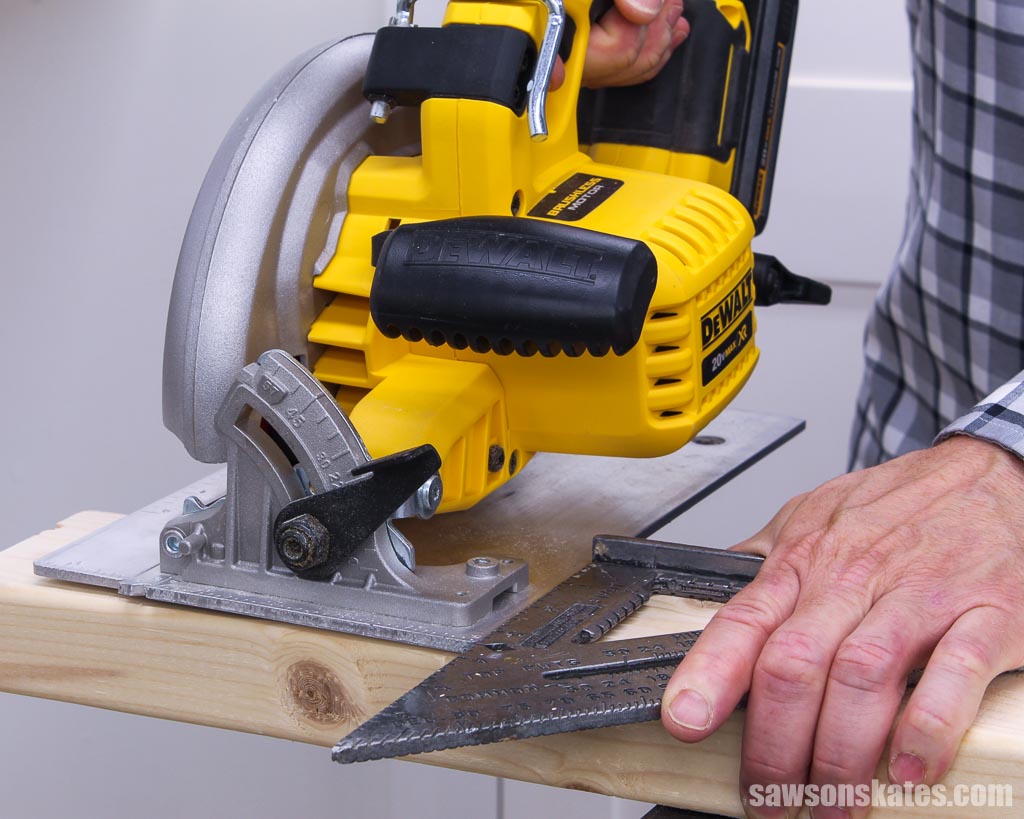
You can also use accessories to cut a straight line with a circular saw, such as the Kreg Rip Cut, Kreg Accu Cut, Kreg Straight Edge Guide, or the Kreg Crosscut Station.
Related: 4 Ways to Make Straight Cuts with a Circular Saw
Types of Circular Saws
Standard
The standard or sidewinder is the most common type of circular saw. The blade is mounted on the side of the motor, and blades range in diameter from 6-½ inches to 7-¼ inches.
Standard saws are versatile and can be used for a variety of tasks, such as cutting plywood and construction lumber. They are also relatively affordable making them a good choice for beginners and budget-minded DIYers.
Related: 9 Woodworking Tools for Beginners
Worm Drive
Worm drive circular saws have their motors positioned at a right angle to the blade. This configuration makes the saw more powerful than a standard saw, but it’s also much larger, heavier, and more expensive.
If you’re a professional carpenter or a do-it-yourselfer who does a lot of heavy-duty cutting, then a worm drive saw might be the best choice for you.
Compact or Miniature
Compact or miniature circular saws have blades ranging in diameter from 3-¼ to 4-¼ inches, making them smaller and lighter than standard saws.
Their compact size is ideal for small-scale projects or projects that require maneuvering in tight spaces. However, they have less power and a smaller cutting capacity than a traditional saw, so you won’t be able to cut thick lumber.
Track Saw
A track saw is a circular saw mounted on a track. Track saws are used to make long, accurate straight cuts in plywood, MDF, and other materials.
If you frequently need to rip wood or want an alternative to a table saw, then a track saw might be the right tool for you.
Choosing the Right Circular Saw
When buying a circular saw, be sure to select the right model for the job you need to do.
A standard or worm drive saw will be more than sufficient for general-purpose cutting. If you need a compact tool for maneuvering in tight spaces or making cuts in small pieces of lumber, then a compact or miniature saw might be your best bet. And if you need to make long, accurate, straight cuts, then a track saw might be your best option.
There are more considerations beyond power and size. You’ll want to consider the blade size and if you need a corded or cordless saw.
Blade Size
Circular saws are available in blade sizes ranging from about 4 inches to 7-¼ inches, while the most common blade size is 6-½ inches.
The blade’s size determines the maximum cutting capacity of the circular saw. The depth of cut is measured from the blade’s tip to the bottom of the plate, and determines how deep of a cut you can make with the saw.
The blade size you need depends on the material you will be cutting and the thickness of the material. For most general-purpose cutting, a circular saw with a blade size between 6-½ and 7-¼ inches will be more than sufficient. While smaller blades can be used to cut thinner materials, they will not be able to cut thicker materials.
Related: How to Change a Circular Saw Blade (+ Blade Direction)
TIP: When choosing a blade for your circular saw, or any saw, you’ll want to consider the tooth count, or TPI (teeth per inch), which is the number of teeth on a saw blade. More teeth will give you a smoother cut, while fewer will provide faster cutting but rougher edges.
Corded or Cordless
Circular saws come in both corded and cordless models. Corded saws offer more power than cordless saws, but they are also connected to an outlet limiting their mobility.
Cordless circular saws are powered by batteries instead of plugged into an outlet. They offer the advantage of moving around freely, but they may not have enough power for some tasks.
Pros and Cons of a Circular Saw
Pros
- Compact and portable
- Versatile, can make a variety of cuts
- Ideal for making long, straight cuts needed for breaking down plywood
- Can make long, angled cuts needed for making roof rafters, etc.
Cons
- Doesn’t make crosscuts, miters, bevels, and compound cuts as accurately as a miter saw
- Requires practice and hand-eye coordination to make straight freehand cuts
What are the Differences Between a Miter Saw and a Circular Saw?
Miter saws and circular saws are both power tools you can use to make various cuts in lumber. Both saws have unique advantages and disadvantages that you’ll want to consider before choosing which is best for your next DIY project.
Rip Cuts
The most significant difference between a circular saw and a miter saw is making rip cuts.
The stand-out feature of a circular saw is its ability to make long, straight rip cuts, such as those required for breaking down a large sheet of plywood. A miter saw is not capable of making rip cuts.
Cross Cuts, Miters, Bevels, and Compound Cuts
A miter saw is designed specifically for making crosscuts, miters, bevels, and compound cuts in lumber. These cuts are needed for trim work, framing, and other woodworking projects.
A circular saw also can make these cuts, but not with the same level of accuracy as a miter saw. However, a circular saw can make steep angled cuts, such as those needed when cutting roof rafters, that are nearly impossible to make with a miter saw.
The bottom line is miter saws make more accurate cuts than circular saws.
Size
Miter saws are heavier and have a larger footprint than circular saws, which are smaller, lighter, more portable, and take up less storage space.
Versatility
Circular saws are more versatile than miter saws but their drawback is they are not as precise as a miter saw.
Safety
Another thing to consider is safety. Because miter saws have a fixed blade with a blade guard, it is less likely that you will accidentally cut yourself while using one.
With a circular saw, there is a greater risk of injury because the blade is exposed and can cause serious injuries if you’re not careful.
Cost
Miter saws are generally more expensive than circular saws.
Should I Buy a Miter Saw or a Circular Saw?
The answer to this question depends on the you need to make and how often you’ll use the saw.
If you need to make a lot of crosscuts, miters, bevels, and compound cuts, then a miter saw is the better choice.
However, a circular saw will be your best choice if you need to make straight rip cuts, such as breaking down plywood.
Frequently Asked Questions
What do you use a miter saw for?
A miter saw is used to make crosscuts, miters, bevels, and compound cuts, commonly used to cut trim, molding, and construction lumber.
Is a miter saw safer than a circular saw?
Yes, miter saws are generally considered safer than circular saws because the blade is fixed in place, and there is less chance of accidentally cutting yourself. Circular saws have exposed blades which can cause serious injuries if you’re not careful.
Can a circular saw do miter cuts?
Yes, a circular saw can make miter cuts but not with the same level of accuracy as a miter saw.
Final Thoughts
Miter saws and circular saws both tools have their own unique advantages and disadvantages.
The type of saw you need depends on the types of cuts you need to make. If you need to make a lot of crosscuts, miters, bevels, and compound cuts, then a miter saw is the better choice. However, a circular saw will be your best choice if you need to make straight rip cuts.
When it comes to safety, miter saws are generally considered safer than circular saws because the blade is fixed in place.
When deciding between a miter saw or a circular saw, the best thing to do is evaluate the type of cuts you’ll need to make most often and choose the saw best suited to make those cuts.
Thank you for stopping by. If you enjoyed this tutorial, would you please take a moment and pin it to Pinterest? I’d really appreciate it!

